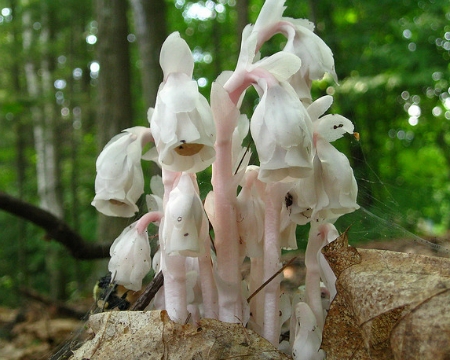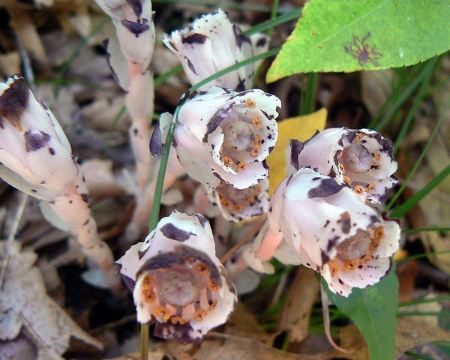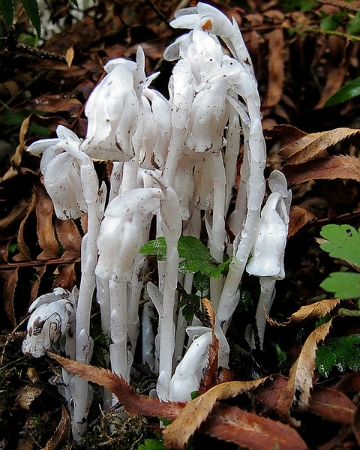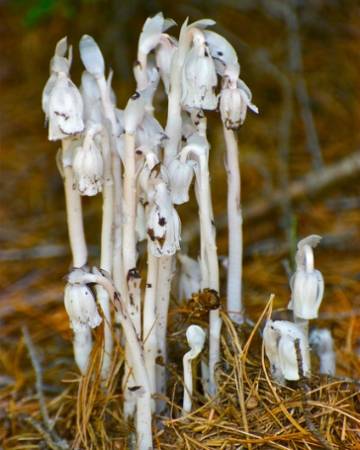





At first glance, this plant looks like a fungus, but its real identity is much more interesting!
I had never heard of Indian Pipe, Monotropa uniflora, until my father-in-law sent me a picture, thrilled that they had found a few specimens near their lakeside cottage for the first time in years. Apparently they used to find a few of these intriguing plants each summer, but they had all but disappeared from the property.

At first glance, I thought the fingerlike stems he'd photographed were some unusual fungus. In actuality, they are a plant with no green parts, entirely lacking chlorophyll necessary for making their own food. The leafless stem, which is covered with bracts that look somewhat like the scales on a lily bulb, extends 3-10 inches above the ground, and curves at the top, with one single, downward-facing flower. This is reflected in its botanical name, which literally means single (mono-) turn (-tropa), single (uni-) flower (-flora).
The stems themselves are brittle and scaly-looking, and are actually cool to the touch, adding the common name Ice Plant to the other descriptive names by which it is known. They are very tender and bruise easily, and "melt" or degenerate into mush when handled roughly or picked. While some varieties have tints of pink or red, in addition to the almost translucent white, most turn brown or blackish as they age, and decompose into a mass of gooey, black sludge.

Plants with no chlorophyll, called heterotrophs, are fairly rare. The lack of need for sunshine allows them to grow in heavy undergrowth and thick, dark wooded areas. With no manner of producing their own food, they are dependent on a host plant to produce the nutrients they need. In this case, the Ghost Plant acts as the parasitic third wheel in an otherwise mutually beneficial symbiotic relationship between a fungus and tree roots, called mycorrhiza. Initially, the tree provides sugars to the fungus, and the fungus provides minerals, especially nitrogen and phosporus, from the soil to the tree. In this case, the Ghost Plant insinuates itself in a nestlike mass of roots into the threadlike strands of fungus growing on the tree roots, benefiting both from the sugars and starches produced by the tree, and from the minerals provided by the fungus. It forces the fungus to procure nutrition both for itself and for the Ghost Plant, and does not benefit the host plant or fungus in return.

Native Americans, however, did find the plant beneficial. They used the juices of the delicate stems to treat eye complaints, perhaps the basis of the common name Eyebright. Early European settlers used the powdered root as a general sedative, and to treat convulsions and nervous complaints, lending the names Fit Root and Convulsion root. I find the stories behind the many common names as interesting as the plant itself!

Indian Pipe requires very specific types of fungi in the Russulaceae and Lactarius families, which are associated only with American beech and a few trees in the pine family. Because of this very specific dependence, it is extremely difficult to transplant or grow if removed from the location where it was found. Despite the fact that the pollinated plant releases thousands of nearly microscopic seeds, propogation is incredibly difficult, and depends entirely on the seeds coming into contact with the threadlike hyphae of its specific host fungus. If you are fortunate enough to come across a specimen of this eerie plant, most often after a summer rain, I strongly recommend you pull out your camera, not your trowel, and follow the wisdom of this saying:
Take nothing but pictures,
Leave nothing but footprints,
Kill nothing but time.
Listed in order of appearance. You may click on the link below to see the original picture on Flickr. My thanks to the photographers who have shared their work on Flickr Creative Commons!
Thumbnail image with introduction: Flickr Creative Commons, submitted by DM. Some rights reserved.
Pinkish Pipestem with cobwebs: Flickr Creative Commons, submitted by Bemep. Some rights reserved.
Blackish Pipestem: Flickr Creative Commons, submitted by Benny Mazur. Some rights reserved.
Bright white Pipestem in leaves: Flickr Creative Commons, submitted by pfly. Some rights reserved.
Pipestem in pine needles: Flickr Creative Commons, submitted by wplynn. Some rights reserved.
Copyright © www.100flowers.win Botanic Garden All Rights Reserved